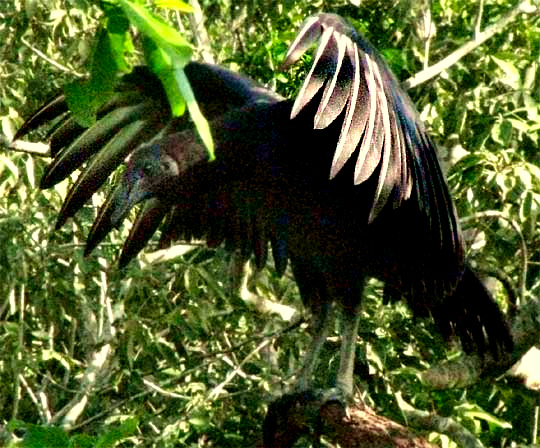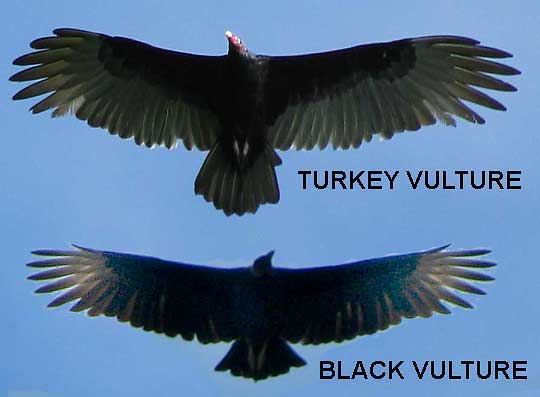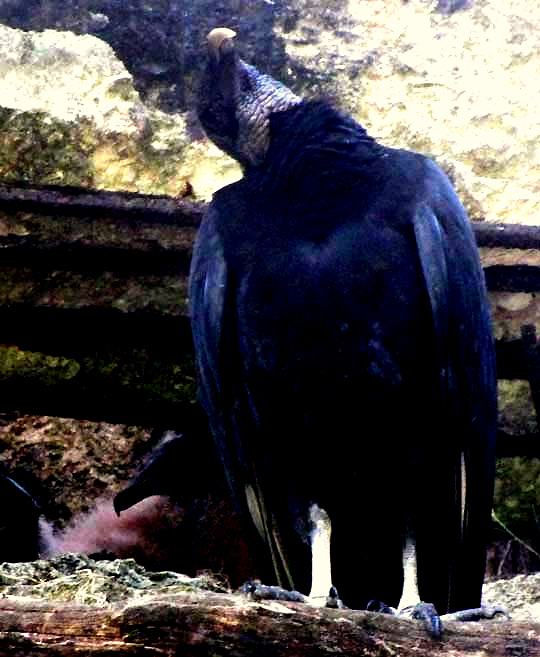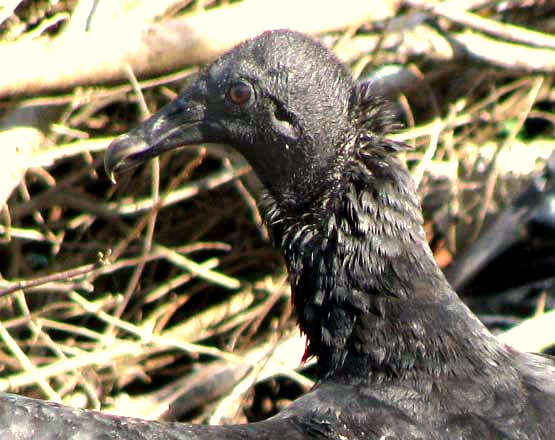Excerpts from Jim Conrad's
Naturalist Newsletter
from the June 12, 2016 Newsletter issued from Hacienda Chichén Itzá, Yucatán, México:
BLACK-VULTURE CENOTE
A water-filled sinkhole, or cenote, near my casita is a roosting spot for Black Vultures.
They overnight there, spend mornings in dead tree snags preening and basking in the
sunlight, in the afternoons circle in convection currents above us, then as the sun sets
they return to the cenote. The cenote provides a sheltered, humid, lush habitat very
different from the surrounding arid, cattle-stomped, hacked-for-firewood scrub, so Tuesday
morning I went there looking for special plants and animals. But before entering I had to
sit awhile to admire those Black Vultures.
I arrived before convection currents begin forming and soon it was clear that the vultures abhorred the idea of taking to the air so early. Getting airborne seemed to be a dreaded chore for them so, if you approach them halfway non-threateningly, you can get fairly close. I drew near them like a lumbering cow, then sat and waited for them to get used to me. Their sounds fascinated me. Vultures are usually described as mostly silent, limiting their vocalizations to grunts and hisses, but the sound that got my attention was one like the woof! of a small, Schnauzer-type dog who can't make up his mind whether he needs to bark or not, so he barks halfheartedly as he looks away.
Later that day as I hiked through the scrub suddenly a loud, wind-ripping, whooshing noise tore through the space above me. At first I thought it was a low-flying jet with his engines off, but then I saw two Black Vultures displaying high in the sky. One vulture would dive at the other from high up, then pull up near the other so sharply that the whooshing sound was tremendous. You can see how this display would serve its purpose during courtship: The stronger the bird, the faster he's able to dive, the sharper he can make his pull-up, and the louder the resulting whoosh. The louder the whoosh, then, the healthier and stronger the prospective mate.

Above you can see a Black Vulture at the cenote basking with his wings held against the sunlight. Tuesday morning sunlight was intermittent, so for long periods all the twenty or so vultures perched preening or just resting, but the moment sunlight broke through, in unison, they'd all unfurl their wings like the one in the photo, and keep them open until the next cloud covered the sun.
Perches were important to those vultures, and birds at the top of the pecking order got the best perches. If Alpha Vulture wanted a perch occupied by a lower-ranked bird he'd simply fly to the lower-ranked bird's perch. If the lower-ranked bird didn't get out of the way automatically, a few pecks would be exchanged, but then the lower-ranked bird would quickly abandon his perch anyway.
The above photo shows the whiteness typical of a Black Vulture's major wing feathers. Howell in A Guide to The Birds of Mexico and Northern Central America describes the Black Vulture's plumage as "black overall, white shafts above and webs below of outer 6 primaries form contrasting whitish wing panels." You can see yourself whether the white is limited to the outer six primaries. When Black Vultures are soaring overhead, their white wing-spots, or "panels," are easily discerned.
In the photo you can also see the vulture's long, stout legs. When I started birding back in the 60s, field guides always placed vulture illustrations among those of hawks and falcons, because vultures were regarded as most closely related to them. Now our New World Vultures are accepted as most closely related to storks, not raptors or even Old World Vultures. Those long legs make their stork affinities easy to believe.
By the way, you can see the difference in silhouettes between an overhead Turkey Vulture and a Black Vulture below:

from the September 7, 2007 Newsletter, issued from from
Sierra Gorda Biosphere Reserve Headquarters in Jalpan, Querétaro, México:
60 BLACK VULTURES JUMPING
On another rainy day this week I walked past a pasture in which over 60 Black Vultures
were scattered in the grass among grazing cattle. Every second or so a vulture would jump
into the air, seem to spread its wings as if trying to frighten something in the grass
before it, and then land in that grass, look into it and sometimes peck there. I was too
far away to see exactly what was happening.
However, I've observed egrets and herons wading in shallow water and a Cooper's Hawk on dry land flashing their wings, apparently trying to scare prey from before them. It looked like the vultures were doing that, though I can't be sure. If I had to guess, I'd say that the vultures were feeding on small, juvenile toads, of which multitudes appeared on the rain-soaked road that day.
It wouldn't be too surprising for this to be case, for Black Vultures are known to take living prey. A page at SheepUSA.Org {used to} warn sheep farmers that Black Vultures "subdue, capture and eat live prey, including birds, skunks and opossums, turtle hatchlings and fish," plus there are stories about them killing livestock.
In fact, Black Vultures have a bit of a thuggish reputation. Black Vultures can't locate decaying carcasses by smell the way Turkey Vultures do. Often Turkey Vultures locate a carcass by its odor, descend to eat, and when Black vultures see the landing Turkeys they land en masse, drive away the less aggressive Turkey Vultures, and eat their fill.
from the March 18, 2012 Newsletter issued from Hacienda
Chichen Resort beside Chichén Itzá ruins, central Yucatán, MÉXICO
FUZZY, WHITE BABY VULTURES
A Black Vulture has made her nest in a nook of an old ruined building at the Hacienda
picturesquely overgrown with strangler fig roots, Night-blooming Cereuses and other
ruin-loving vegetation. You can see the wary mama vulture giving me the eye from about
fifteen feet up as one of at least two fuzzy, white nestlings peeps around her side below:

from the December 5, 2010 Newsletter issued from Hacienda
Chichen Resort beside Chichén Itzá ruins, central Yucatán, MÉXICO
VULTURE EARS
At Pisté's municipal dump I was searching for interesting escaped plants but about the
only thing going on there was the Black Vultures, hundreds of them, feeding on abandoned
carcasses, butcher-shop discards, etc. The big birds were so complacent that they'd let me
get within ten feet before flying. I took a picture of one just for the novelty of being
able to get so close. You can see the bird's head below.

Notice the lack of feathers on the head, a condition enabling the bird to insert his head into gore and withdraw it without the mess catching beneath his feathers. Also notice the hole behind the eye. That's the ear hole.
Other birds have ear holes, too, but usually they're covered with feathers.
from the April 27, 2014 Newsletter issued from the valley
of the Dry Frio River in northern Uvalde County, southwestern Texas, on the southern
border of the Edwards Plateau; elevation ~1750m (~5750 ft); N29.62°, W99.86°; USA
JARVIS'S VULTURE NOTES
Two weekends ago my friend Jarvis from graduate school days visited, driving round-trip
between Asheville, NC and here. Jarvis is a retired college professor who specializes in
ecology and birds, and in recent years has been paying special attention to vultures. Upon
his return to Asheville, he wrote:
"I saw a very great number of vultures in southern and central Texas compared with other regions - probably more than 5 times as many per hour compared with states other than Texas. Also, I saw more Black Vultures in Texas than I could easily count. I saw no Black Vultures in Louisiana or Mississippi and only 3 in Alabama (on the way out and back). I suspect there is a close correlation between the population of cows and the population of vultures. Maybe the deer population is a factor as well."
Lloyd Kiff's paper published in 2000, "The Current Status of North American Vulture," points out that from the 1950s to the early 1970s, North American vulture populations declined because of the use of DDT but now the populations are stable and in fact Black and Turkey Vultures are extending their ranges northward.
Kiff supposes that behind this northward range extension lie increases in the deer population, increased availability of road-killed animals, reduced pesticide use, reduced human persecution, the increased number of landfills, and a general warming trend.